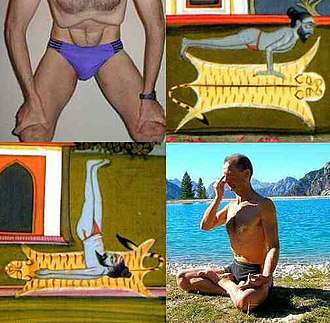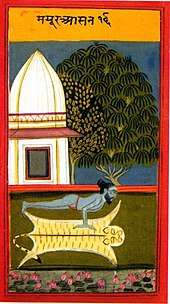Hatha Yoga Pradipika
The Haṭha Yoga Pradīpikā (Sanskrit: haṭhayogapradīpikā, हठयोगप्रदीपिका or Light on Hatha Yoga) is a classic fifteenth-century Sanskrit manual on haṭha yoga, written by Svātmārāma, who connects the teaching's lineage to Matsyendranath of the Nathas. It is among the most influential surviving texts on hatha yoga. The Hatha Yoga Pradīpikā is also one of three classic texts on haṭha yoga, alongside the Gheranda Samhita and the Shiva Samhita.[1]
Title and composition
Different manuscripts offer various versions of the text's title. The database of the A.C. Woolner manuscript project at the Library of the University of Vienna gives the following variant titles, gleaned from different manuscript colophons: Haṭhayogapradīpikā, Haṭhapradīpikā, Haṭhapradī, Hath-Pradipika.[2]
The Hatha Yoga Pradīpikā was composed by Svātmārāma in the 15th century CE.[3] as a compilation of the earlier haṭha yoga texts. Svātmārāma incorporates older Sanskrit concepts into his synthesis. He introduces his system as a preparatory stage for physical purification before higher meditation or Raja Yoga.
Summary

Hatha Yoga Pradīpikā lists thirty-five earlier Haṭha Yoga masters (Skt. siddha), including Ādi Nātha, Matsyendranātha and Gorakṣanātha. The work consists of four chapters that include information about purification (Skt. ṣaṭkarma), posture (āsana), breath control (prāṇāyāma), spiritual centres in the body (chakra), coiled power (kuṇḍalinī), force postures (bandha), (kriyā), energy (śakti), subtle/gross bodily connections (nāḍī), and symbolic gestures (mudrā), among other topics.
It runs in the line of Hindu yoga (to distinguish from Buddhist and Jain yoga) and is dedicated to The First Lord (Ādinātha), one of the names of Lord Śiva (the Hindu god of destruction and renewal), who is described in several texts from the Dattātreyayogaśāstra onwards as having imparted the secret of haṭha yoga to his divine consort Pārvatī.
Modern research
In the twenty-first century, research on the history of yoga has led to a more developed understanding of hatha yoga. In analyzing the Hatha Yoga Pradīpikā, as well as other works by Svātmārāma, researchers better understand the origins of hatha yoga.[5]
James Mallinson has thoroughly studied the origins of hatha yoga and has worked with classic yoga texts such as the Khecarīvidyā. He has identified a collection of eight works that introduce early hatha yoga and contribute directly to its official formation in the Hatha Yoga Pradipika. Many of his conclusions from these early works revise earlier understandings about the formation of yoga.[6]
Jason Birch has investigated the role of the Hatha Yoga Pradīpikā in popularizing an interpretation of the Sanskrit word haṭha. The text drew from classic texts on different systems of yoga, and Svātmārāma grouped what he had found under the generic term "haṭha yoga". Examining Buddhist tantric commentaries and earlier medieval yoga texts, Birch found that the adverbial uses of the word suggested that it meant "force", rather than "the metaphysical explanation of uniting the sun (ha) and moon (ṭha)".[7]
Notes
- Master Murugan, Chillayah (20 October 2012). "Veda Studies and Knowledge (Pengetahuan Asas Kitab Veda)". Silambam. Retrieved 31 May 2013.
- University of Vienna. "Svātmārāma - Collected Information". A Study of the Manuscripts of the Woolner Collection, Lahore. University of Vienna. Retrieved 24 March 2014.
- Moti Lal Pandit (1991). Towards Transcendence: A Historico-analytical Study of Yoga as a Method of Liberation. Intercultural. p. 205. ISBN 978-81-85574-01-1.
- Mallinson, James & Singleton, Mark (2017). Roots of Yoga. Penguin Books. p. xx. ISBN 978-0-241-25304-5. OCLC 928480104.
- See, e.g., the work of the members of the Modern Yoga Research cooperative
- http://www.modernyogaresearch.org/people/c-m/dr-james-mallinson/
- Birch, Jason (2011). "The Meaning of haṭha in Early Haṭhayoga". Journal of the American Oriental Society. 131: 527–554. JSTOR 41440511.
External links
- Iyangar, Srinivasa, Tookaram Tatya, A. A. Ramanathan, S. V. Subrahmanya Sastri, and Radha Burnier, eds. 1972. The Haṭhayogapradīpikā of Svātmārāma with the Commentary Jyotsnā of Brahmānanda and English Translation. Adyar: The Adyar Library and Research Centre.
- Sanskrit text and English translation of the Pancham Sinh edition at sacred-texts.com (archive.org)
- Hatha Yoga Pradipika Flash Version of the Pancham Sinh edition from LibriPass
- Akers, Brian. 2002. The Hatha Yoga Pradipika PDF of selected pages from a new translation by Brian Akers, from the publisher's website
- Ajīta (raja-yoga.org), 2003 (1893-1995). Hatha Yoga Pradipika. 89 pp. (PDF) Translation of the original text with the Jyotsnā commentary of Brahmananda from Sanskrit in English by Srinivasa Iyangar/Tookaram Tatya (1893) on behalf of the Bombay Theosophical Society Publishing Fund, Corrected by Prof. A. A. Ramanathan, Pandit S. V. Subrahmanya Sastri and Radha Burnier (1972) of the Adyar Library and Research Center, The Theosophical Society, Adyar, Madras 20, India. With interpretation and comments by Philippe “Ajīta” Barbier (1993) of The Raja Yoga Institute, Aalduikerweg 1, 1452 XJ Ilpendam, Holland. Translation of interpretation and comments from Dutch to English by Ben Meier (1995).
- Downloadable PDF of the Pancham Sinh edition, from brihaspati.net
- Hatha Yoga Pradipika English by Michael Beloved - an easy read translation in lucid English.
- Kundalini Hatha Yoga Pradipika by Michael Beloved - devanagari, word-for-word meanings, fluid English translation, elaborate commentary with details of inSelf Yoga.
![]()
